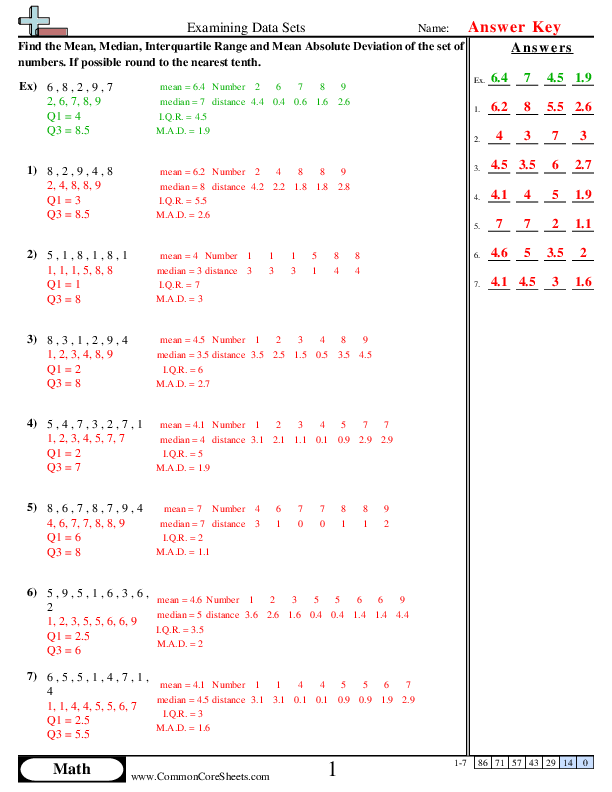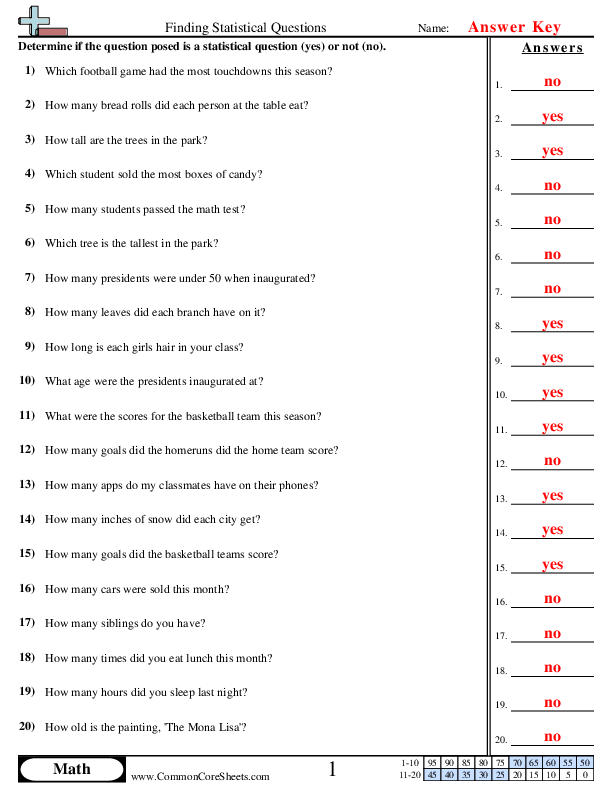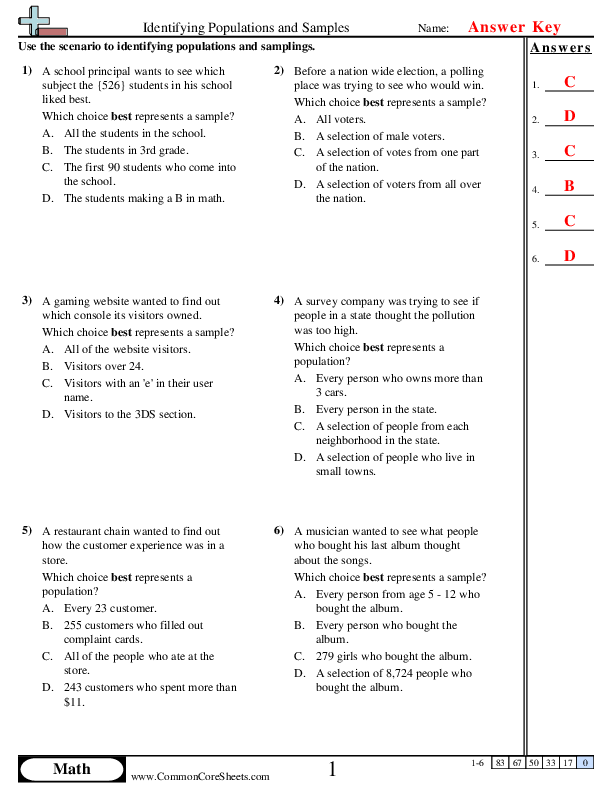
Our statistics worksheets are the best on the internet for helping students understand and practice statistical concepts. With a variety of free data sets to choose from, students can gain hands-on experience answering statistical questions and analyzing data. These worksheets are a great resource for students of all levels, from introductory statistics courses to advanced data analysis. Whether you are looking to improve your understanding of mean, median, mode, or any other statistical concept, our statistics worksheets have you covered. So why wait? Start practicing with the best statistics worksheets on the internet!
Jump to a Heading > Filter By Grade > List View (old) Image Size Smaller Larger Cheat Sheets Link
× Description:
"This worksheet is designed to guide through conceptual understanding of the subject 'Cheat'. Even though it doesn't contain problems, it can be easily customized depending on individual needs. It’s an excellent resource for distance learning, and can also be conveniently converted into flashcards for quick revision purposes. Breakthrough learning positively, with this versatile worksheet." × Student Goals:
Cognitive Development
After completing the worksheet, students will have developed and enhanced their cognitive skills. They will have grown notably in their capacity to analyse and understand the subject matter, interpreting and processing information in a swift and effective manner. This will play a crucial role in their overall intellectual growth and enhance their ability to grasp complex concepts more readily.
Critical Thinking Skills
Through the worksheet, students are expected to have developed more robust critical thinking abilities. The tasks will have provoked them to think deeply as well as challenge their existing beliefs and ideas about the subject. They will have learned how to logically diagnose problems, think creatively, and make reasoned judgements.
Enhanced Knowledge Base
Students will have broadened their knowledge base on the subject matter after completing the worksheet. This will not only make them more informed but also arouse an inherent curiosity to learn more and delve deeper into the subject. Every new piece of information they have learned provides a foundation for existing knowledge, and expands upon it.
The completion of the worksheet promotes and encourages self-directed learning among students. They learn how to independently approach the tasks, thereby fostering a sense of responsibility and self-dependence. This paves the way for lifelong learning, and helps them become proactive learners.
The worksheet is designed in a manner to provide students with scenarios that require sound decision-making skills. After completion, the student will have a better understanding of how to analyse situations, evaluate options and make sound decisions in a timely manner.
By working through the worksheet, students develop necessary time management skills. They will have learned how to effectively allocate time to different tasks and make optimum use of the available resources. This experience will not only be beneficial academically, but also in their future professional endeavours.
Advertisement Numerical Data Link
6sp5c × Description:
"This worksheet is designed to improve children's understanding of math, particularly data sets. It features seven problems, each detailing different numerical sequences, and challenges learners to examine and analyze key statistical concepts, including mean, median, I.Q.R., and M.A.D. Valuable for distance learning, the worksheet can be customized to suit individual learners and potentially converted into flash cards for more dynamic study sessions." × Student Goals:
Data Analysis
After completing this worksheet, students will gain substantial skills in analyzing data sets. They'll learn how to organize data in a meaningful way, improve their understanding of different statistical measures such as mean, median, and mode, and appreciate the differences and uses of these measures in real life scenarios.
Evaluation of Quartiles and Interquartile Range
Students will learn how to compute the first (Q1) and third (Q3) quartiles of a data set and understand their significance. Furthermore, they'll gain the ability to find the Interquartile Range (IQR), which provides a measure of statistical dispersion, or how data is spread around the mean.
Calculation of Mean Absolute Deviation
Completing this worksheet will equip students with the skill to calculate the Mean Absolute Deviation (M.A.D.), a measure that indicates the average distance of each data point from the mean. This understanding will enable students to examine the dispersion or variability in a data set profoundly.
The worksheet involves an array of different data sets, contributing to a deeper understanding on how data can be distributed. Students will learn how to observe patterns and variations in the data distribution, developing a more intuitive sense for statistics.
Application of Mathematical Concepts
By finishing the worksheet, students will enhance their ability to apply various mathematical concepts to real-life situations. They will gain a more profound understanding of the practical uses of statistics in numerous professional fields like economics, sociology, psychology, and many others.
This worksheet will also aid in improving the students' problem-solving and critical thinking skills. It requires them to apply different statistical approaches and techniques to solve problems, thereby improving their logical reasoning and mathematical skills.
Advertisement Statistic Word Problems Link
6sp1 × Description:
"This worksheet is designed to enhance children's understanding of statistical questions in math. It offers 20 unique problems, ranging from querying numbers of pets in a neighborhood, to analyzing real-world data like monthly car sales. This customizable educational tool helps engage kids in active learning, suitable for both classroom and distance learning contexts. It also has the versatility to be converted into flash cards to facilitate learning through games." × Student Goals:
Understanding Statistical Questions
By the end of this worksheet, students should have a clear understanding of what makes a question a statistical one. They will be able to recognize and distinguish between questions that solicit statistical data and those that don't. This exercise will allow them to internalize the characteristics of statistical questions, emphasizing on variability, randomness, and data distribution within a specific group or population.
As an outcome of this worksheet, students will be equipped with the ability to formulate statistical questions applicable in real world situations. They will learn how these queries can be used in various fields such as sports, weather forecasting, business sales, and popular opinion. This skill can largely influence their critical thinking and decision making, encouraging them to make fact-based conclusions.
Students will learn how to approach questions analytically. They will be able to identify the type of data needed, how it could be collected and how it should be analyzed to answer each specific query. Moreover, they will understand the relevance of using different methods of analysis depending on the nature of the data collected. This will provide a groundwork for their upcoming mathematical topics involving data and probability.
Improvement in Problem Solving Skill
Working on this worksheet will enhance students' problem-solving skill. They will learn to break down complex questions into two or more simpler issues and solve each of them sequentially. The students can then apply this skill in other mathematical problems as well as non-mathematical problems in day-to-day life.

7sp1 × Description:
"This worksheet is designed to enhance children's understanding of the mathematical concepts of populations and samples. It includes 6 distinct problem scenarios in contexts like politics, market research, and environmental studies, each with multiple-choice answers. Adaptable for a variety of learning formats, this resource can be customized, converted into flashcards, or utilized in distance learning environments." × Student Goals:
Statistical Understanding
After completing this worksheet, students should have an improved grasp of basic statistics- specifically regarding the concepts of populations and samples. This understanding will assist them in making informed decisions about suitable samples and populations in various contexts, enabling them to accurately interpret and critique survey and polling data in real-life situations.
The worksheet's problems are designed to engage the student's problem-solving skills. They will be able to evaluate different scenarios, identify relevant data, and choose the appropriate statistical group (population or sample). This will not only reinforce their mathematical critical thinking abilities, but it will also enhance their overall problem-solving capabilities, which are an essential part of quantitative reasoning.
As students navigate through the problems, they will be exercising their analytical thinking skills. They'll learn to differentiate between complete (population) and selected subsets (samples) based on certain criteria in scenarios varying from politics, customer service, environmental concerns, and entertainment. This type of analysis lays the foundation for higher-level statistical studies and data interpretation skills.
The real-world problems included in this worksheet are centered around situations commonly encountered in daily life- opinion polls, customer reviews, environmental surveys, and gaming preferences. Students will learn to not just understand these concepts theoretically, but to also apply this knowledge practically. This will aid them in making sense of the world around them, from understanding election polls to interpreting customer feedback in business scenarios.
Foundation for Advanced Studies
Completing this worksheet paves the way for more advanced studies in statistics and related fields. With the solid foundation in understanding populations and samples, students will be well-equipped to deal with complex topics such as data collection methods, distribution, inferential statistics, hypothesis testing, correlations, and regression.